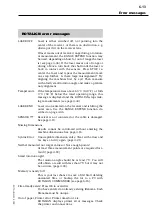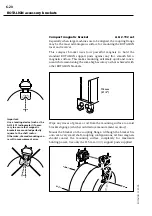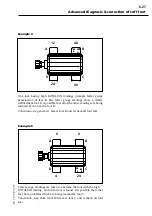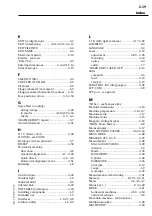
6-24
ROTALIGN 01.2000
Advanced diagnosis & correction of soft foot
Advanced diagnosis & correction of soft foot
Besides the two most common types of soft foot previously discussed
(page 4-29)
—
parallel and angular soft foot
—
a number of other
problems may cause excessive soft foot readings:
If ROTALIGN measures a soft foot, but feeler gauges cannot be
inserted beneath the foot, there may be rust or dirt beneath the foot:
This type of "spongy" foreign matter can expand when the foot bolt is
loosened so that ROTALIGN reads a soft foot, yet still keep a feeler
gauge from being inserted. Correct the situation by using a power
wire brush to clean the undersides of the machine feet and the base,
and replace any damaged shims. Take care to completely remove all
dust and dirt from the top and sides of the feet as well to prevent
recontamination, and limit the number of shims beneath any one
foot to 4.
External forces, such as those exerted by attached piping, supports,
couplings or other machine parts, may induce soft foot readings until
the shaft alignment is improved. This may be checked by removing
the suspected source of strain, then taking a second set of readings
for comparison.
Sometimes ROTALIGN will register little or no soft foot, yet feeler
gauge measurements indicate quite a substantial gap beneath the
machine feet. This can occur if either the base or machine feet bend
without bending the machine housing (for example due to underdi-
mensioning or damage). As a result, shimming corrections may not
bring the expected improvement, but often satisfactory alignment
may still be achieved, even without filling the foot gap beforehand.
So long as the ROTALIGN shows no soft foot reading when the foot
bolts are tightened or loosened, the shaft is not moving, so no harm
can occur to the rotor, bearings or coupling.
In some cases, the ROTALIGN soft foot function registers shaft
deflections which are actually caused by irregularities of the individ-
ual feet. The only way to check the contact of each foot to the
machine base is to use feeler gauges at the corners of the feet. These
readings may then be considered in combination with the ROTAL-
IGN soft foot results as illustrated by the examples on the following
pages.
Содержание ROTALIGN ALI 3.500
Страница 13: ...1 10 ROTALIGN 01 2000 This page intentionally left blank ...
Страница 103: ...4 66 ROTALIGN 01 2000 This page intentionally left blank ...
Страница 121: ...5 18 ROTALIGN 01 2000 This page intentionally left blank ...
Страница 143: ...6 22 ROTALIGN 01 2000 This page has intentionally been left blank ...
Страница 158: ...6 37 ROTALIGN 01 2000 This page intentionally left blank ...






























